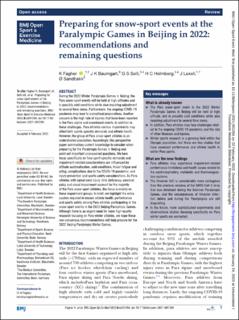| dc.contributor.author | Fagher, K. | |
| dc.contributor.author | Baumgart, Julia Kathrin | |
| dc.contributor.author | Solli, Guro Strøm | |
| dc.contributor.author | Holmberg, Hans-Christer | |
| dc.contributor.author | Lexell, J. | |
| dc.contributor.author | Sandbakk, Øyvind | |
| dc.date.accessioned | 2023-03-06T12:12:39Z | |
| dc.date.available | 2023-03-06T12:12:39Z | |
| dc.date.created | 2022-05-03T14:06:00Z | |
| dc.date.issued | 2022 | |
| dc.identifier.citation | BMJ Open sport & exercise medicine. 2022, 8 (1), . | en_US |
| dc.identifier.issn | 2055-7647 | |
| dc.identifier.uri | https://hdl.handle.net/11250/3056031 | |
| dc.description.abstract | During the 2022 Winter Paralympic Games in Beijing, the Para snow-sport events will be held at high altitudes and in possibly cold conditions while also requiring adjustment to several time zones. Furthermore, the ongoing COVID-19 pandemic may lead to suboptimal preparations. Another concern is the high rate of injuries that have been reported in the Para alpine and snowboard events. In addition to these challenges, Para athletes various impairments may affect both sports-specific demands and athlete health. However, the group of Para snow-sport athletes is an understudied population. Accordingly, this perspective paper summarises current knowledge to consider when preparing for the Paralympic Games in Beijing and point out important unanswered questions. We here focus specifically on how sport-specific demands and impairment-related considerations are influenced by altitude acclimatisation, cold conditions, travel fatigue and jetlag, complications due to the COVID-19 pandemic, and injury prevention and sports safety considerations. As Para athletes with spinal cord injury, limb deficiency, cerebral palsy and visual impairment account for the majority of the Para snow-sport athletes, the focus is mainly on these impairment groups. In brief, we highlight the extra caution required to ensure athlete health, performance and sports safety among Para athletes participating in the snow-sport events in the 2022 Beijing Paralympic Games. Although there is an urgent need for more high-quality research focusing on Para winter athletes, we hope these non-consensus recommendations will help prepare for the 2022 Beijing Paralympic Winter Games. | en_US |
| dc.language.iso | eng | en_US |
| dc.publisher | BMJ Publishing Group Ltd | en_US |
| dc.rights | Navngivelse-Ikkekommersiell 4.0 Internasjonal | * |
| dc.rights.uri | http://creativecommons.org/licenses/by-nc/4.0/deed.no | * |
| dc.title | Preparing for snow-sport events at the Paralympic Games in Beijing in 2022: recommendations and remaining questions | en_US |
| dc.title.alternative | Preparing for snow-sport events at the Paralympic Games in Beijing in 2022: recommendations and remaining questions | en_US |
| dc.type | Peer reviewed | en_US |
| dc.type | Journal article | en_US |
| dc.description.version | publishedVersion | en_US |
| dc.source.pagenumber | 0 | en_US |
| dc.source.volume | 8 | en_US |
| dc.source.journal | BMJ Open sport & exercise medicine | en_US |
| dc.source.issue | 1 | en_US |
| dc.identifier.doi | 10.1136/bmjsem-2021-001294 | |
| dc.identifier.cristin | 2021033 | |
| cristin.ispublished | true | |
| cristin.fulltext | original | |
| cristin.qualitycode | 1 | |

